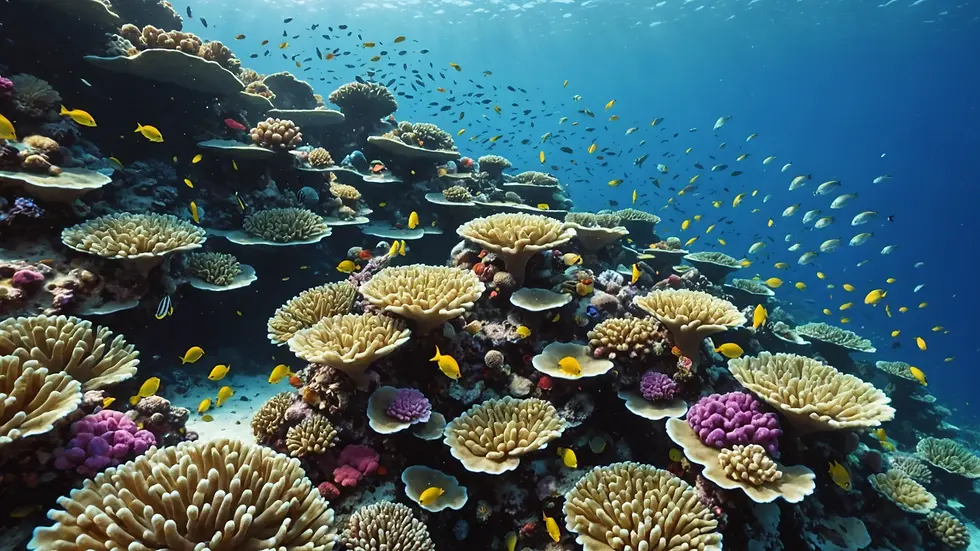Exploring the Intricate Dynamics of Peaceful Fish Communities: A Closer Look
- Jyotiraj Borah
- Feb 10
- 3 min read
Imagine a vibrant underwater world where fish of all colors swim together in harmony. Peaceful fish communities are not just beautiful; they represent vital ecosystems that rely on complex relationships among their members. In this post, we will explore the dynamics of these communities, the benefits they offer, and the environmental factors that help sustain them.
Understanding Fish Communities
Fish communities consist of multiple species coexisting within a specific habitat. Factors like geographic location, water quality, and other organisms greatly influence these communities. Peaceful fish, known for their non-aggressive nature, display social behaviors that promote coexistence and harmony.
In these communities, fish take on various roles. For example, cleaner wrasses eat parasites off larger fish, benefiting both parties in the process. Such interactions highlight the balance essential for thriving ecosystems.
The Importance of Biodiversity
Biodiversity plays a critical role in healthy fish communities. A varied population means that no single species solely relies on the same resources, which decreases competition. In a study conducted in the Great Barrier Reef, researchers found that communities with 50 or more species had a 20% higher resilience to climate change impacts compared to those with only 10 species.
The diversity seen in peaceful fish communities is impressive, showcasing different shapes, sizes, and colors from species like clownfish to angelfish. This variety not only adds beauty to our oceans but also fortifies ecosystems against environmental stressors.
Peaceful Interactions Among Species
Many fish species engage in cooperative behaviors that enhance their community's well-being. For instance, in a symbiotic relationship, gobies and shrimp work together, with gobies acting as lookout while shrimp dig and maintain their shared burrow. This partnership illustrates how cooperation flourishes in peaceful fish communities.
Schooling is another fascinating behavior. Fish like sardines and herring swim in large groups, creating a stunning display. This strategy offers safety in numbers, allowing them to escape predators effectively. Schools can reduce individual predation risk by up to 70% when compared to solitary fish.
Environmental Factors Influencing Peaceful Communities
Numerous environmental elements are vital in sustaining the balance of peaceful fish communities. Let's take a closer look at three key factors:
Water Quality: Clean water is crucial for fish survival. Pollutants can cause stress, leading to aggressive behaviors among species. For example, when ammonia levels increase in polluted waters, fish are more likely to exhibit territorial aggression, disrupting community harmony.
Temperature: Fish have specific temperature needs. Maintaining the right thermal conditions helps ensure peaceful coexistence. For instance, tropical fish thrive at temperatures around 26-30°C, while cooler species prefer around 15-20°C. Fluctuating temperatures can lead to resource shortages and increased competition.
Habitat Structure: The physical environment is essential for peace in fish communities. Structures like reefs, rocks, and plants provide hiding spots and breeding grounds for various species. Research shows that coral reefs can boost fish populations by over 50% compared to barren substrates, illustrating the significance of habitat complexity.
The Role of Education and Awareness
Raising public awareness about peaceful fish communities is vital for their protection. Educational campaigns can help people understand their importance and encourage actions that preserve these habitats. For instance, local initiatives can promote clean-up events in aquatic environments, enhancing the health of these ecosystems.
Aquarium enthusiasts also play a role in responsible practices. It is essential to research compatible species and ensure the tank environment mimics natural habitats. This approach enhances the health and happiness of fish, contributing to the overall community’s stability.
Conservation Efforts for Peaceful Fish Communities
Human activities pose threats to aquatic ecosystems, making conservation a priority. Sustainable fishing practices, habitat restoration, and pollution reduction are essential for protecting peaceful fish communities.
Organizations focused on conservation advocate for protecting aquatic environments. Collaborative projects can connect communities, policymakers, and scientists. For example, initiatives that educate fishermen about sustainable methods can help reduce overfishing and preserve fish populations.
The Future of Peaceful Fish Communities
The future of peaceful fish communities relies on collective efforts to protect their habitats. Climate change presents challenges, but proactive steps can help mitigate its effects.
Implementing marine protected areas (MPAs) can safeguard essential habitats from human impact. Research shows that MPAs can increase fish populations by approximately 600%, helping support the sustainable growth of these communities.
Final Thoughts
Peaceful fish communities illuminate the beauty and complexity of nature. Their dynamics provide valuable lessons about cooperation and resilience while emphasizing the need for environmental protection. By prioritizing education, conservation, and sustainable practices, we can help ensure these vibrant communities continue to thrive for future generations.







Comments